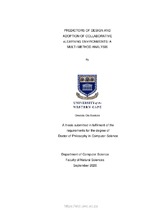| dc.description.abstract | Research has shown that collaborative eLearning can provide educational opportunities to groups of learners; both distance learners as well as traditional campus-based learners. It provides innovative educational methods in which learning can be constructed. The way collaborative eLearning is administered, managed, used and adopted can assist in providing information for future design and improvement of collaborative software. The objective of this research is to provide an insight into adoption and use of collaborative eLearning environments and to discover new determinants of usage.
To examine the usage of an eLearning environment at the University of the Western Cape, a cross-sectional survey was conducted with Computer Science students. While this study is specific to this university, the underlying principles can be generalised to other organisational types. This study is quantitative and qualitative in nature as well as deductive and inductive. Three hundred and six valid questionnaires were analysed using quantitative methods. Soft Systems Methodology was used to manage the research process and to create conceptual models to explain the research problem and identify solutions. It was a cyclical process.
Findings show that although the university’s eLearning platform is utilised, students seem to prefer free and open source platforms. They use social and collaborative applications such as WhatsApp, Telegram, Dropbox, Google Drive, Google Docs as well as email messages. Four types of technology affordances: communicative-affordance, document share-affordance, course resource-affordance, and integrity-affordance were identified as being relevant in their choice of application. Furthermore, culture—masculinity/femininity, individualism/collectivism, Uncertainty Avoidance, and Power Distance—also have an effect on the adoption of collaborative eLearning applications and software the students used for learning. Chi-Square analysis found that individualism/collectivism and Power Distance were both significant and related to the adoption and usage of collaborative eLearning. Gender was found not to be a determinant of how students view the use of collaborative eLearning software applications. Finally, it was also found that understanding use and user behaviour, could provide the theoretical guidance to inform collaborative eLearning design.
The analysis and findings show that culture influences the adoption of collaborative eLearning while technology affordance plays a major role in the use of collaborative eLearning. | en_US |

